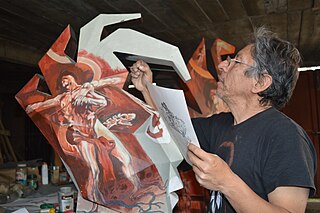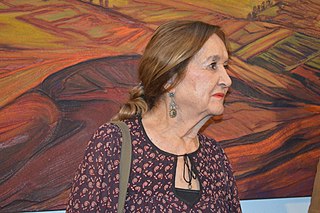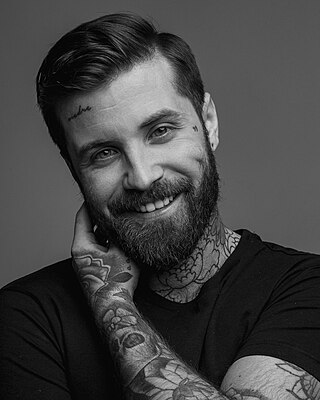| The Nine Confinements or The Deprivation of Liberty | |
|---|---|
| Artist | Abel Azcona |
| Year | 2012 - 2016 |
| Medium | Performance Art |
| Location | Bogota, Lyon, Madrid, Houston |
The Nine Confinements, also known as The Deprivation of Liberty is a conceptual, endurance art and performative work of critical and biographical content by artist Abel Azcona. The artwork was a sequence of performances carried out between 2013 and 2016. All of the series had a theme of deprivation of liberty. The first in the series was performed by Azcona in 2013 and named Confinement in Search of Identity. [1] The artist was to remain for sixty days in a space built inside an art gallery of Madrid, with scarce food resources and in total darkness. The performance was stopped after forty-two days for health reasons and the artist hospitalised. [2] Azcona created these works as a reflection and also a discursive interruption of his own mental illness, being one of the recurring themes in Azcona's work. [3]
Another of the confinements lasted nine days in the Lyon Biennale. Azcona remained inside a garbage container strategically located in the center of the Biennial as a criticism of the artist's own gestation and the market of contemporary art itself. [4] One of the last projects of the series was Black Hole. Performed in 2015, Azcona again remained locked in a small space without light and poor food in the same central art gallery in Madrid. On this occasion different unknown guests shared the confinement with the artist. Azcona was unaware of the guests origins and could not see them. [5] Visitors of the art gallery were told of the experience by those entering and leaving the confinement with to the artist. All projects were curated and documented from the point of view of the deprivation of liberty including deprivation of food, water, electricity or contact with the outside. [6]

Performance art is an artwork or art exhibition created through actions executed by the artist or other participants. It may be witnessed live or through documentation, spontaneously developed or written, and is traditionally presented to a public in a fine art context in an interdisciplinary mode. Also known as artistic action, it has been developed through the years as a genre of its own in which art is presented live. It had an important and fundamental role in 20th century avant-garde art.

Endurance art is a kind of performance art involving some form of hardship, such as pain, solitude or exhaustion. Performances that focus on the passage of long periods of time are also known as durational art or durational performances.
Papo Colo is a Puerto Rican performance artist, painter, writer, and curator. He was born in San Juan, Puerto Rico. He lives and works in New York City and in El Yunque rainforest in Puerto Rico. Papo Colo is an interdisciplinary artist, whose work ranges from performance, theater and installation art to painting, writing, and graphic design.

Nicolás García Uriburu was an Argentine artist, landscape architect, and ecologist. His work in land art was aimed at raising consciousness about environmental issues such as water pollution.
Mauricio Sotelo is a Spanish composer and conductor.

Antonio García Vega is a Mexican artist and member of the Salón de la Plástica Mexicana. He began exhibiting his work while still in school in the early 1970s and continues to do so, often working with his brother Mauricio García Vega. He works in mixed media to paint various forms of expression. His early work was mostly fantastic, with elements of eroticism but his later work has been darker as a means of expressing his own feelings and moods. His work has mostly been exhibited in Mexico, often in conjunction with other artists including a 2010 exhibition with his brother at various venues.

Rina Lazo Wasem was a Guatemalan-Mexican painter. She began her career in mural painting with Diego Rivera as his assistant. She worked with him from 1947 until his death in 1957 on projects both in Mexico and Guatemala. Thereafter, she remained an active painter, better known for her mural works than canvases, although the latter have been exhibited in Mexico and other countries. This has made her one of Guatemala's best-known artists. She was a member of the Mexican muralism movement and criticized modern artists as too commercial and not committed to social causes. She believed muralism would revive in Mexico because of its historical value.
Mario García Torres is a visual and conceptual artist. He has used various media, including film, sound, performance, ‘museographic installations’ and video as a means to create his art.

Abel Azcona is a Spanish artist, specializing in performance art. His work includes installations, sculptures, and video art. He is known as the "enfant terrible" of Spanish contemporary art. His first works dealt with personal identity, violence and the limits of pain; his later works are of a more critical, political and social nature.
Amen, more commonly known as The Pederasty, is a conceptual, critical and process artwork by Abel Azcona. Over several months, Azcona attended Eucharists in churches and parishes that were linked to his childhood. In the churches, the artist keeps the wafer or consecrated host given to the attendees of the communion. He gathered two hundred and forty-two wafers, which was the number of cases of pederasty reported in the north of Spain during the previous decade. With the wafers, he made a work in which the word Pederasty could be read. The work was first exhibited at a central Madrid art gallery in the summer of 2015.
Empathy and Prostitution is a conceptual and performative work of critical and biographical content by artist Abel Azcona. Azcona was inspired by his biological mother, a prostitute, and sought to empathise with her and with the moment of his own conception. Azcona offered himself naked to the galleries' visitors on a bed with white sheets, so that they could exchange intimacy or have sexual relations with him.

The Death of The Artist is a conceptual and performative work of critical content by artist Abel Azcona. The artwork was both a continuation of his earlier works and closure of the series, being performed in 2018 in the lobby of the Circulo de Bellas Artes in Madrid. His previous works had caused Azcona to receive threats, persecution, and acts of violence. By letter, the artist invited the organizations, groups, and entities that had threatened his life to the installation, where a loaded firearm was offered and Azcona stood exposed on a raised platform.

The Fathers is a conceptual and performative work of critical and biographical content by artist Abel Azcona. The Fathers was first performed in 2016 in Madrid with the final performance, also in Madrid, in 2017 in an exhibition format. The durational piece included dozens of female survivors of prostitution who gave a physical description of their last client. On the other side of a ten-meter-long table, composite artists listened to them and drew images of the clients. The performance generated dozens of portraits which, at the closing of the work in 2017, were exhibited with the premise that any of them could be Azcona's father. The biographical work creates a critical discourse with prostitution and its inheritance, and in the case of Azcona himself, of an unknown father, having been conceived during an act of prostitution.
Abel Azcona, the son of a prostituted woman who is looking for his whoremonger father, because it perfectly summarizes everything that the patriarchy has built on their subordination and for our autonomy. Abel represents the aching son of an unknown father. All of us are those men who walk on their backs. To those who do not see their faces until the end. Those parents who sign unwritten covenants and who leave their semen springs across the planet. Those who rent vaginas, wombs, and maids. It is urgent to face those who prefer to remain installed in comfort. Only in this way will it be possible to turn our face towards the camera, without fear of being recognized in a robot portrait of a whoremonger father. Without fear of the mirror returning the image of a monster.
Buried is a conceptual and performative work of critical, social and political content by artist Abel Azcona. The performance artwork was created in 2015 through a public and participatory performance, or happening, on the esplanade of Franco's Monument to the Fallen in Pamplona. Azcona invited dozens of relatives of Republicans who were shot, persecuted or disappeared during the Spanish Civil War. Descendants of victims make up the installation in a row in front of the monument, all symbolically buried with soil from the garden of one of the participants, where his relatives had been shot. In 2016 the city of Pamplona invited Azcona to show his work inside the Monument and the project was recreated inside the Monument, which had been converted into an exhibition hall, under the name of Unearthed: A retrospective view on the political and subversive work of the artist Abel Azcona. The exhibition brought together the Buried project and fragments of all of Azcona's works.
There are symbols that cannot be covered. The Monument to the Fallen of Pamplona is a clear example. Fighting this symbol with another is what Navarrese artist Abel Azcona has proposed, known for his performance, sometimes controversial and often linked to the body. In this case, Azcona does not propose this new art exhibition as a war between symbols, but as an invitation to arouse feelings and, also, as a claim. For him, it is about inciting memory, individual and collective.
Eating is a conceptual and performative work of critical, polemical and political content by artist Abel Azcona. Also known as Eating a Koran, Eating a Torah and Eating a Bible.
The Shadow is a conceptual and performative work of critical, social and political content by artist Abel Azcona. In The Shadow, Azcona denounced cases of child abuse in a piece in which the survivors are the protagonists. In the work, Azcona presented more than two hundred actual cases of pedophilia in museums and galleries in various cities in Spain. At each show, Azcona gave a live performance from a wooden swing of the experiences of the survivors.

The Shame is a conceptual, critical and process artwork by Abel Azcona. Developed along the West Bank Wall in 2018, in The Shame Azcona installed original fragments of the Berlin Wall along the Israeli wall in the West Bank, which forms part of the barrier built throughout Israel to separate the Palestinian lands. Azcona made a metaphorical critique by merging both walls in the work. The actual installation, as if it were a piece of land art, currently remains along the wall, and has been exhibited in different countries through photographic and video art. The Israeli government has prohibited the artist from entering Israel because of the piece.
The Streets is a conceptual and performative work of critical and biographical content by artist Abel Azcona. At the end of 2014 and the early part of 2015, Azcona explored the processual work La Calle this time in the Santa Fe locality of Bogota, where he prostituted himself on the streets. In this new work, he explored a change towards the figure of his mother, taking hormones and engaging in prostitution. Azcona was inspired by his biological mother, a prostitute, and sought to empathise with her and with the moment of his own conception. The process continued in the cities of Madrid and Mexico City. The performance emerged, as with the rest of his sex-themed works, as an exercise in empathy with his own biological mother. It was also a social critique, where the artist explored the limits of his body by repeating patterns of sexual abuse, which occurred in his own childhood and in the life of his mother.
File 09812 is a conceptual and performative work of critical and biographical content by artist Abel Azcona. The artist shows, in an art installation and documentary way, his Social Welfare file, fully exposed in various occasions. These documents speak of a child in a situation of total abandonment, with visible signs of abuse, neglect and malnutrition, and testimonies from neighbors and the environment are provided confirming that the child could be left for weeks in total solitude in the apartment, which did not meet the minimum habitability conditions. The documentary installation is accompanied by a performative reading of each of the pages of the file by Abel Azcona himself. The artwork was responsible for inaugurating the International Contemporary Art Fair of the Mediterranean. The work was part of the retrospective exhibition dedicated to the artist by the city of Pamplona in 2015.
Disturbing and disconcerting. Intimate and emotional. Abel Azcona, who had already been seen by the fair, walks barefoot and dressed completely in black on the esplanade of the Palau de la Festa and surroundings. He stands among the people, who await him. He gets on stage with some papers. File No. 09812 begins. Azcona stands facing the public, who is staring, and begins to read the file. And so, among the coldness of those mechanical words and administrative jargon, his childhood is recounted; prostitute mother, drug addict father, from house to house, environments in which a child should never be found, social services, an expensive attempt at adoption by a foster family and even sexual abuse. A long process that evidences a hard childhood. Azcona finishes reading File No. 09812, his file. He finishes and gets off the platform, leaves the esplanade and walks through the surroundings in tears until Enrique Bocángelus, director of the International Contemporary Art Fair of the Mediterranean Mars, approaches him and they merge into a hug. People, meanwhile, read the file, perhaps trying to understand why a child has to go through something like that or simply thanking him for being able to expose it that way. Mars is silent, and that is only the first day.

Spain Asks for Forgiveness is a conceptual and performative work of critical and anti-colonial content by recognized artist Abel Azcona. Created and started in Bogotá in November 2018 through a conference and a live performance by Azcona at the museum of contemporary art of Bogotá.